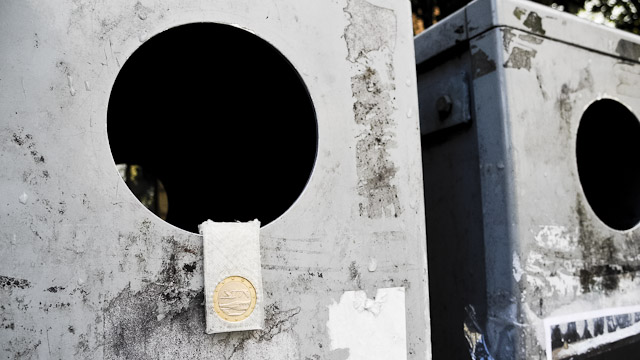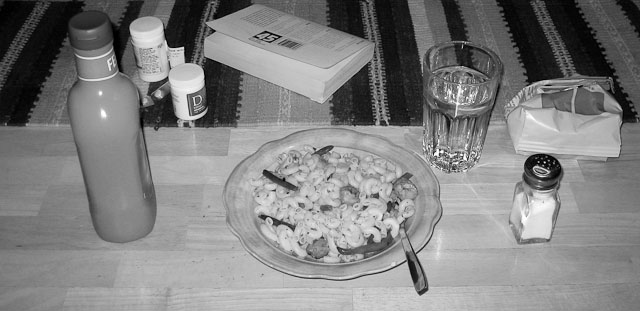I’m learning to do silkscreen printing again, and I’m making all the mistakes one would expect; I Overexpose the film, don’t dry the mask properly and forget to harden the emulsion. Too much paint or too little; Too much pressure or too little. And I’m ordering paper samples like there’s no tomorrow.
As much as I look away with poorly hidden mirth when Jan is espousing the merits of one balsamico over another, I’m at the moment hip deep in primers on paper, absorption and paint. So where he has discerning taste buds, I have rough fingertips and Wikipedia. Slave to the geek within.
A month or so ago I became a member of KKV, a workshop for artists doing craft. There are welders, carpenters, printers and potters, and most of them are seriously dedicated to doing stuff by hand. They make me nervous, because I feel like a self-conscious cynic among optimists. This whole thing with materiality, and the high value of craft, sneaks up on me every once in a while. People at KKV talk about stuff as if the stuff was what mattered and not the social interpretation of the stuff.
Because we’re such tactile and fundamentally primitive creatures, it’s easy to understand this drive to interpret ones surroundings directly, and project meaning (and value) onto them so literally. Feel the grain of the paper. Look at the pearl-like coating of the paint. Well. Smell the coffee of fucking post-materiality, you sack of neurons!



Almost immediately when I started printing, I was reminded by a dialogue by Banks in Look Windward, where a human composer and an A.I. discuss the merits of art and the value of labour, when the former is not a result of the latter:
— You have to think like a mountain climber.
— Oh, do I?
— Yes. Some people take days, sweat buckets, endure pain and cold and risk injury and — in some cases – permanent death to achieve the summit of a mountain only to discover there a party of their peers freshly arrived by aircraft and enjoying a light picnic.
— If I was one of those climbers I’d be pretty damned annoyed.
— Well, it is considered rather impolite to land an aircraft on a summit which people are at that moment struggling up to the hard way, but it can and does happen. Good manners indicate that the picnic ought to be shared and that those who arrived by aircraft express awe and respect for the accomplishment of the climbers.
— The point, of course, is that the people who spent days and sweated buckets could also have taken an aircraft to the summit if all they’d wanted was to absorb the view. It is the struggle that they crave. The sense of achievement is produced by the route to and from the peak, not by the peak itself. It is just the fold between the pages.[…]
— How far do I have to take this analogy, Cr Ziller?
— You’ve made your point, but this mountain climber still wonders if he ought to re-educate his soul to the joys of flight and stepping out onto someone else’s summit.


I’ve done three posters so far, all of which in connection with events which Skup Palet has organised. The exhibition Dip To Black with Jesper Norda and Sara Lännerström, a book launch with Signe Vad, and the Textival party this Saturday. We’ve hung original, one-of-a-kind, prints in the rain and sleet as we would any poster; The hand-craft and resources are treated as disposable, instead of being numbered and sold as signed graphic art.
I’m at KKV because I’d like to find a middle ground between worshipping the craft and the idea. What is the value added of me printing posters by hand which just as well have been printed in an inkjet printer? There must be something more to being an artist than just calling them giclée prints, right? Even if you take the errors into account — the diminutive differences between copies caused by human inaccuracy — this bastion of human expression can be substituted with a randomness generator, so what’s the point of doing it by hand?
I’d argue that what I’m adding to the finished object is the time and labour, and more specifically, the marketing of time and labour. You might buy my numbered and signed prints if you knew that there was 40 minutes worth of work behind it, as opposed to the non-effort an inkjet offers. You’re paying for my discomfort so that you can hang my 40 minutes on your wall.
Up to a certain point you can argue that some art is “better” than other, after which it really becomes a question of taste and trends. Beyond a certain limit the inherent value of all that work, the hours learning and thinking and planning, is not something which you see in the resulting object. But if you’re told that it’s the result of six months of suffering and planning and execution? Why, you’d have to be truly monstrous not to appreciate the artistry.
Speaking of objects of desire, two things I want: The Rauschen 4 album and the complete Bembo Book font face family. I just redesigned the Skup Palet business cards, and although the Bembo is nice, I wouldn’t mind the lower x-height; This is what craft has reduced me to, soiling myself over type before the computer at night…








